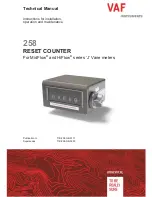
29
Lifting the Control Center — Care should be used to prevent
damage due to dropping or jolting when moving the control
center. A fork truck or similar means of lifting and transporting
may be used. Sling in a manner that will equalize the load at the
pickup points. Use a spreader bar if the angle of the sling is less
than 45 degrees relative to horizontal. Do not jolt while lifting.
Use the following procedure to lift the control center.
1. Remove the rubber hole plugs in the top of the control
center and fully thread in 4 eyebolts or swivel hoist rings
(see Fig. 28). Lifting hardware must have
3
/
4
in.-10 x 2 in.
long threads and must have a working load limit of at
least 6000 lb (2722 kg). Typical eyebolts are Chicago
Hardware (size 28) or Grainger (P/N 5ZA63).
2. Attach a sling to the four lifting eyebolts. Make certain
that the angle of the sling is not less than 45 degrees
relative to horizontal.
3. Using an overhead or portable hoist (minimum 2 ton
rated capacity), attach a free-fall chain to the sling
secured to the drive. Take up any slack in the chain.
4. Rig the control center and remove the bolts that secure it
to the VFD mounting brackets on the condenser (see
5. Confirm that welding procedures comply with local
Pressure Vessel Codes before removing a portion of the
VFD support bracket from the condenser. Custom brack-
ets should be fabricated if part of the VFD supports must
be cut off of the condenser to reduce the width of the
condenser assembly. Clamp ¼-in. plates over both sides
of the VFD bracket and drill two pairs of holes that
straddle the line along which the VFD brackets will be
cut. This will allow the VFD brackets to be reinstalled
and welded in their original position.
NOTE: To reassemble, follow steps in reverse order. Connect
sensors and cables after major components have been secured
to reduce the risk damaging them. (See Fig. 29 and 30.)
REMOVE THE DISCHARGE PIPE ASSEMBLY FROM
THE CONDENSER
NOTE: For steps 1 through 6 refer to Fig. 17 for units with Q,
R compressor, or Fig. 18 for units with P compressor.
The condenser relief valve and relief valve vent piping should
be removed if they will interfere with discharge pipe assembly
rigging.
1. Remove the discharge pipe assembly relief valve and
relief valve vent piping, if applicable.
2. Disconnect the compressor discharge temperature sensor.
3. Disconnect the compressor discharge pressure sensor and
remove the high discharge pressure switch.
4. Unbolt and rig the discharge pipe assembly off and re-
move the bolts from the compressor discharge and con-
denser inlet flange. Note the position and orientation of
the discharge isolation valve on the condenser inlet
flange.
5. Remove the discharge pipe assembly.
6. Cover all openings.
NOTE: To reassemble, follow steps in reverse order. Connect
sensors and cables after major components have been secured
to reduce the risk of damaging them.
SEPARATE THE COMPRESSOR
The VFD blocks access to the compressor mounting bolts.
It must be removed before the compressor can be separated
from the condenser. Remove the VFD from the condenser us-
ing the Remove the Controls/Drive Enclosure section on
OIL HEATER CONDUIT A
S
Y
OIL PUMP CONDUIT A
S
Y
VAPORIZER HEATER CONDUIT A
S
Y
OIL RECLAIM
ACTUATOR CABLE
VFD COOLING LINE
O-RING FACE
S
EAL
COUPLING
S
VFD COOLING
S
OLENOID CABLE
TEMPERATURE
S
EN
S
OR
CABLE
S
PRE
SS
URE
S
EN
S
OR
CABLE
S
Fig. 27 — Control Panel Back
a23-1571
NOTE: The P compressor uses drive without VFD cooling lines.
CAUTION
Do not rig the heat exchanger before the control center and
compressor are removed. The assembly has a high center
of gravity and may tip over when lifted at the tubesheet rig-
ging points, which could result in equipment damage and/
or serious personal injury.
45° MIN
LIFTING
EYEBOLT
3
/4 IN. - 10 x 2 IN. LIFTING EYEBOLT WITH
S
HOULDER OR
S
WIVEL HOI
S
T RING
6000 LB (2722 KG) WORKING LOAD LIMIT
TYPICAL — CHICAGO HARDWARE P/N 2
8
GRAINGER P/N 5ZA6
3
Fig. 28 — Control Center Lifting Points
a23-1561
Summary of Contents for EVERGREEN 23XRV
Page 53: ...53 Fig 60 Typical Field Wiring Schematic LF 2 VFD Shown NOTE See Notes for Fig 60 on page 56 ...
Page 54: ...54 Fig 60 Typical Field Wiring Schematic LF 2 VFD Shown cont a23 1585 ...
Page 55: ...55 Fig 60 Typical Field Wiring Schematic LF 2 VFD Shown cont a23 1586 ...
Page 60: ...60 Fig 63 23XRV Controls Schematic LF 2 ...
Page 64: ...64 FROM PREVIOUS PAGE Fig 67 23XRV Controls Schematic Rockwell Standard Tier VFD Shown cont ...












































